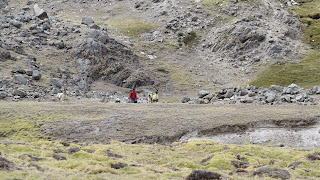A week in the mountains seems so simple. But nothing ever is simple. In a way just getting here is a big deal.
First, the local community has to agree to the area being used for tourism. Cordillera Real areas like Condoriri and Huyana Potosi crossed that hurdle long ago. The Chachacomani area we spent the last week in was opened only three years ago. That makes us one of the earliest groups to visit there.
 |
| Jose is a local man from the Chachacomani community who has encouraged opening this area for climbing, i.e. tourism. Only since 2010 can climbers access this area. It remains very little visited today. |
Second, equipment and food for a week takes lots of help to move into the mountains. To get here takes a 4x4 ride from La Paz to Peñas where the dirt road starts. The dirt road eventually deteriorates considerably into basically an adventure ride for folks used to precipitous views. Finally, three to four hours later, we park at Jose´s house where we meet with porters and pack animals.
Third, the hike in to base camp takes close to three hours. It is not steep at all -- we gained perhaps 100m in elevation. There is a lot of wind though.And the views are typical Cordillera Real, that is, stunning.
 |
| Here´s the valley near the start of the hike in. It gets drier higher up. |
 |
| Thanks to burros for carrying our stuff ... |
 |
| ... and thanks to the llamas and porters, too! |
 |
| First view of Chachacomani, one of this area´s 6,000+ metre summits. |
Fourth, local community people have to be recruited to act as porters and helpers. This in a place without communications. To talk to someone, you have to show up at their house. Imagine!
 |
| The breakfast table. Juan, our cook, made sure we were well fueled. |
 |
| Our job is really to be acclimatized, stay healthy, eat food and climb. |
There are lots of superstitions locals have about the mountains they live amongst. Eduardo told about meeting with practically every person in the community to talk about mountaineering and allowing climbers to use this area. Jose was instrumental in creating that conversation. Coming from places where mountain tourism and mountain culture is normal, it is valuable to understand better the work needed to establish access in new places where neither really exists. And I am happy to be able to experience a part of the world few have seen up close and personal as we have over this last week.









































